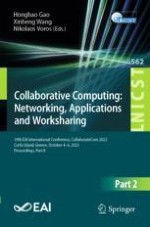The three-volume set LNICST 561, 562 563 constitutes the refereed post-conference proceedings of the 19th EAI International Conference on Collaborative Computing: Networking, Applications and Worksharing, CollaborateCom 2023, held in Corfu Island, Greece, during October 4-6, 2023.
The 72 full papers presented in these proceedings were carefully reviewed and selected from 176 submissions. The papers are organized in the following topical sections:
Volume I : Collaborative Computing, Edge Computing & Collaborative working, Blockchain applications, Code Search and Completion, Edge Computing Scheduling and Offloading.
Volume II: Deep Learning and Application, Graph Computing, Security and Privacy Protection and Processing and Recognition.
Volume III: Onsite Session Day 2, Federated learning and application, Collaborative working, Edge Computing and Prediction, Optimization and Applications.
